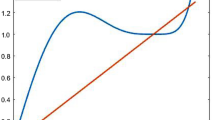Abstract
Signal Processing algorithms generally rely heavily on the convolution operation which in turn is multiplication intensive. However, more recently convolution algorithms based on the squaring operation as opposed to the multiplication operation have been developed. In this article we present two ROM based methods for performing the squaring operation modulo 2n, modulo 2n−1, or modulo 2n+1. The performance, cost, and implementation issues of the two methods are analyzed in detail and compared against each other as well as with a traditional ROM based implementation. It is shown that both methods obtain ROM bit savings of 99.99%, for 32-bit word lengths, when compared with traditional techniques. However, one of the methods outperforms the other in all other respects such as overhead costs, of up to 99.48% savings, performance, up to about 20 times faster, and regularity and simplicity of hardware design.
Similar content being viewed by others
References
A.V. Oppenheim and R.W. Schafer,Digital Signal Processing, Englewood Cliffs, New Jersey: Prentice Hall, 1975.
A. Skavantzos and P.B. Rao, “New Multipliers Modulo 2N−1,”IEEE Transactions on Computers, 1992, pp. 957–961.
P.B. Rao and A. Skavantzos, “New Multiplier Designs Based on Squared Law Algorithms and Table Look-ups,”Proceedings of the Twenty-Sixth Annual Asilomar Conference on Signals, Systems and Computers, Pacific Grove, CA, pp. 686–690, 1992.
F.J. Taylor, “Large Moduli Multipliers for Signal Processing,”IEEE Transactions on Circuits and Systems, vol. CAS-28, 1981, pp. 731–736.
M.A. Soderstrand and C. Vernia, “A High-Speed Low-Cost ModuloP i Multiplier with RNS Arithmetic Applications,”Proceedings of the IEEE, vol. 68, 1980, pp. 529–532.
M.A. Soderstrand and E.L. Fields, “Multipliers for Residue Number Arithmetic Digital Filters,”Electronics Letters, vol. 13, no. 6, 1977, pp. 164–166.
K. Hwang,Computer Arithmetic, New York: John Wiley and Sons, 1979.
G.A. Jullien, “Implementation of Multiplication, Modulo A Prime Number, with Applications to Number Theoretic Transforms,”IEEE Transactions on Computers, vol. C-29, 1980, pp. 899–905.
P.T.P. Tang, “Table-Lookup Algorithms for Elementary Functions and Their Error Analysis,”Proceedings of the Tenth IEEE Symposium on Computer Arithmetic, Grenoble, France, 1991, pp. 232–236.
A. Skavantzos, “ROM Table Reduction Techniques for Computing the Squaring Operations Using Modular Arithmetic,”Proceedings of the Twenty-Fifth Annual Asilomar Conference on Signals, Systems and Computers, Pacific Grove, CA, 1991, pp. 413–417.
P.B. Rao and A. Skavantzos, “Efficient Computation of the Squaring Operation in Modular Rings,”Electronics Letters, vol. 28, no. 17, 1992, pp. 1628–1630.
S. Waser and M.J. Flynn,Introduction to Arithmetic for Digital Systems Designers, New York: Holt, Rinehart and Winston, 1982.
Author information
Authors and Affiliations
Rights and permissions
About this article
Cite this article
Rao, P.B., Skavantzos, A. ROM based methods for computing the squaring operation in modular rings. Journal of VLSI Signal Processing 7, 199–211 (1994). https://doi.org/10.1007/BF02409397
Received:
Revised:
Published:
Issue Date:
DOI: https://doi.org/10.1007/BF02409397




